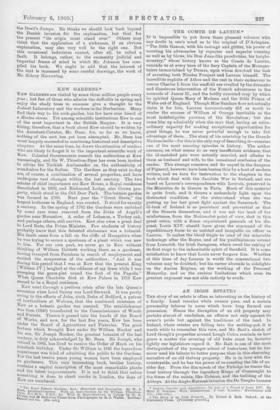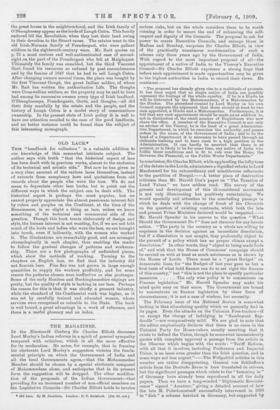AN IRISH ESTATE.f
THE story of an estate is often as interesting as the history of a family. Land remains while owners pass, and a certain personality inheres in acres which have long formed one possession. Hence the disruption of an old property may partake almost of vandalism, an offence not only against its owner's pride but against the traditions of the land. In Ireland, where estates are falling into the melting-pot, it is worth while to remember this view, and Mr. Rait's sketch of Lord Gough's properties around Lough Cutra reminds us how grave a matter the severing of old links must be, however lightly our legislators regard it. Mr. Rait is one of the most distinguished of the younger school of historians, but be has never used his talents to better purpose than in this charming narrative of an old Galway property. He is in love with the countryside, and he has the power of re-creating the life of an elder day. From the dim epoch of the Firbolgs he traces the local history through the legendary Kings of Connaught to the times of the saints, like Colman, and the building of the Abbeys. At the Anglo-Norman invasion the De Burghs became Laustot, Conrtior and Adventurer: the We of a Friend of Louis XIV. By Mary F. Sanders. With Illustrations. 2 vols. London : Hutchinson and Co. 1248. net.] t The Story of an Irish Property. By Robert S. Bait Oxford: at the Ualvoralty Prom. [Privately printed.] the great house in the neighbourhood, and the Irish family of O'Shaughnessy appear as the lords of Lough entre. This family endured till the Revolution, when they lost their land owing to their devotion to the Stuart cause. The estates went to the old Irish-Norman family of Prendergast, who were gallant soldiers. in the eighteenth-century wars. Mr. Rait quotes on p. 72 a most curious and well-authenticated case of second- sight on the part of the Prendergast who fell at Malplaquet. Ultimately the family was ennobled, but the third Viscount Gort found his resources so reduced by past encumbrances and by the famine of 1847 that he had to sell Lough Cara. After changing owners several times, the place was bought by the first Viscount Gough, the great Indian soldier, of whom Mr. Reit has written the authoritative Life. The Goughs were Cromwellian settlers, so the property may be said to have had among its successive owners every type of Irish landlord. O'Shaughnessys, Prendergasts, Gorts, and Goughs,—all did their duty manfully by the estate and the people, and the history of Lough Clutra is a model story of conscientious ownership. In the present state of Irish policy it is well to have our attention recalled to the case of the good landlords, and no better instance could be found than the subject of this interesting monograph.










































 Previous page
Previous page